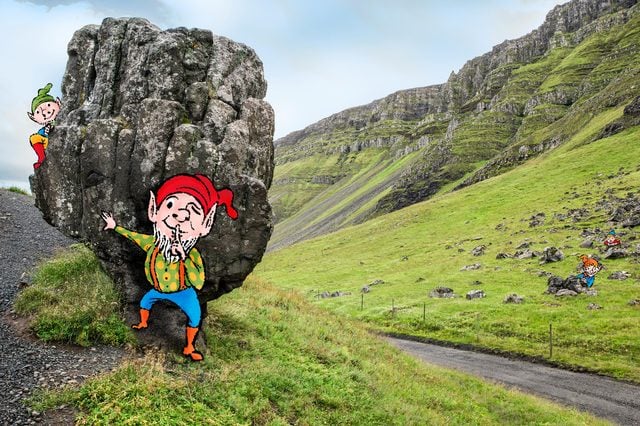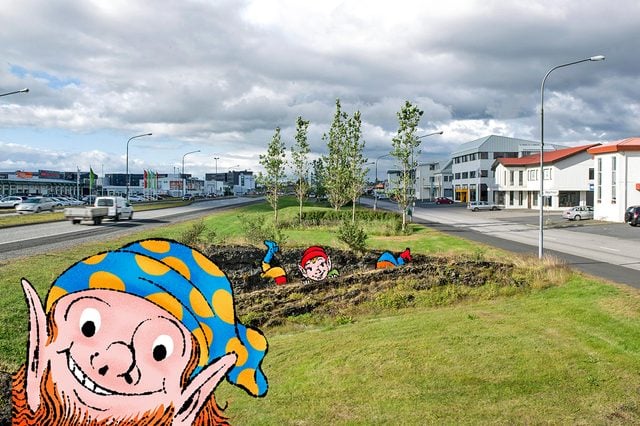What It’s Like in the Town Where They Re-Route Roads to Avoid Elves
Updated: Feb. 15, 2023
Don't you dare mess with the elves!

Just south of Iceland’s capital of Reykjavik, in the city of Kopavogur, a two-lane street in a quiet residential area abruptly loops and narrows to avoid a small hill dotted with lichen-speckled rocks. The diversion seems inexplicable, but anyone round here will tell you the reason is simple: Elves live in those rocks.
It’s been that way since the 1970s, when road-builders were stymied here by accidents and equipment breakdowns. Nearby residents explained that elves were responsible for the problems. The contractors persisted, but the breakdowns continued. It became a hot news story. Finally, the road-builders gave up and looped round the hill.
There are many such spots in Iceland—houses with distorted walls, narrowed driveways, roads suddenly split in two—all to accommodate the Icelandic elves and the huldufolk (“hidden people”), two similar elves, of Iceland.
Iceland’s elves were first mentioned about 1,000 AD in Viking-era poems, but for the next nine and a half centuries this remote island nation rising from the North Atlantic just below the Arctic Circle remained cut off from the rest of the world.
Its people lived in a fantasy landscape—roaring waterfalls, deep fiords, mossy lava fields, glaciers, eerie glacial lagoons, active volcanoes, bubbling geysers and towering cliffs. This surreal aura was a breeding ground for the supernatural. Stories of elves came down through the generations.
Very little changed in much of Iceland until WW II when British and American armies opened bases in Iceland. Modernisation came quickly, and today Iceland is a nation of 325,000 people and one of the most literate, educated and technologically advanced countries in the world. Nevertheless, elf belief persists. Recent surveys suggest that three per cent of Icelanders claim to have had personal encounters with elves, eight per cent believe in elves, and 54 per cent will not deny that elves exist.

Accordingly, construction projects including roads, factories, dams and hospitals are occasionally modified to protect elves or at least delayed to give them time to move to a new place. For some big projects, consultants with clairvoyant skills are brought in to ensure that there is no adverse impact on elves.
When The nation’s economy collapsed in 2008, one of the avenues its leaders looked to for recovery was tourism. While Iceland’s natural wonders were the top draw, the Tourist Board also thought elf belief could lure visitors.
Hoardings began appearing on the main road from the airport to Reykjavik offering tours of elf villages, people painted little elf doors on rocks and vendors touted t-shirts that said, “I had sex with an elf in Iceland… five minutes ago.” Elf Garden, a fairy-tale park of lava rocks, opened in Hafnarfjördur, a small town south of Reykjavik.
Not everyone in Iceland was pleased. Bryndís Björgvinsdóttir, a folklorist at the Iceland Academy of Arts, saw a threat to her country’s identity, part of a shared cultural memory. “I didn’t want elf belief to be trivialised,” she explains.
Several years ago she and photographer Svala Ragnars began documenting elf sites all over Iceland. They’ve nailed down about 40 so far, but she thinks there are many, many more.
“I don’t know if elves exist,” she says. “But elf belief exists. Elves represent nature in our culture. By protecting and respecting nature, humans respect the elves. Their homes—rocks, hills, cliffs—must not be ‘messed with.’
She opens her laptop and begins a slide show of the findings so far. A hospital in Selfossi cancelled an expansion when attempts to move a rock caused communications problems throughout the hospital. Last year on the island of Hrísey a doctor tried to add a patio to his house but the equipment kept malfunctioning and he cancelled the project.
“Fairy-faith can be seen as an opposition to the big bulldozer and industrialisation. People who see elves often demonstrate side by side with environmentalists,” she says.
Bryndís drives to her home town of Hafnarfjördur on Iceland’s southwest coast. “When I was growing up I only knew of three elf spots, but now we’ve already documented 40.” When we get there she shows me where Hafnarfjördur Church has a shortened wall to accommodate a rock. “Christianity and paganism side by side.”

Why are rocks so often involved? “Iceland is made out of lava. There are no big trees or animals to see, so the biggest rocks are most likely to grab people’s attention and become some kind of a landmark.”
She drives inland, stops at a section of new road and wrinkles her nose in disgust. “This road goes right across one of the most interesting and beautiful lava fields in Iceland.”
It was here that elf believers teamed up with environmentalists in 2015 to block a road project through a picturesque lava field in the Álftanes peninsula. The elf advocates claimed the construction would disturb a 30-ton boulder that was an elf church. The environmentalists said the work would destroy a lava field that was a culturally significant landmark—and they stood in front of bulldozers to make their point. The State Road Company finally decided to work with a psychic who claims she can talk to elves, and the boulder was moved—in cooperation with the elves themselves—to a different site where it could stay an elf church.
“It’s difficult to travel anywhere in Iceland without being reminded of the rapid and unexpected change that can occur in the natural world,” says Terry Gunnell, a folklore professor at the University of Iceland. Terry has been studying elves since he emigrated here from England some 35 years ago.
“Icelanders’ houses can be knocked down by a force they can’t see—an earthquake. The wind can literally knock you off your feet. The kitchen taps smell like sulfur because there’s lava just below your feet. Five years ago we had a volcano erupt that disrupted air travel all over Europe.
“This land is alive,” Terry continues, “and it makes sense that many Icelanders would see nature as having a persona. And so if an Icelander wanted to move a stone in the garden to make way for a jacuzzi and someone said, ‘That’s an elf stone,’ would they move it? Absolutely not!”
Back at Reykjavik University, Haukur Ingi Jónasson says that in Iceland elves represent a universal need to believe there is something beyond the physical. Jónasson is now an engineering professor, but he studied elves extensively during graduate studies in theology and psychoanalysis.
“The elves honour a balance of power that has always leaned clearly in the direction of nature and the whimsy of its erupting volcanoes, shifting glaciers, and quivering ground. We are always at the disposal of something that is not us. It’s ‘it’. It’s nature. It’s out there. We cannot control it.”